2012 下半年河北教师资格高中英语学科知识与教学能力真
题及答案
一、 单项选择题(总题数:22,分数:60.00)
1.It was between 1830 and 1835the modern newspaper was born.
A.when
B.that √
C.which
D.while
2.who had arrested him three times for smuggling.
A.Before John stood the policeman √
B.Before the policeman stood John
C.Before the policeman John stood
D.Before John the policeman stood
3.John can play the guitar, and.
A.Mary play the violin
B.Mary can the violin
C.Mary can play
D.Mary the violin √
4.Anthony, a meticulous young man,watered his neighbors' plants once a week while
they were on vacation.
A.eagerly
B.perpetually
C.diligently √
D.haphazardly
5.The Euro has, but the dollar is up.
A.deprecated
B.depreciated √
C.depressed
D.depraved
6.Dog-sitting for Buddy is easy to do; he is aand obedient pet.
A.delectable
B.commonplace
C.meddlesome
D.docile √
7.Which of the following sets of phonetic features characterizes the English
phoneme[MISSING IMAGE]?
A.[+semi-closed, +back, -rounded]
B.[+semi-open, +back, +rounded] √
C.[+closed, +back, +rounded}
D.[+open, +front, +rounded]
8.The phoneme /n/ in the first word of all the following phrases changes to /m/
except.
�
A.open book
B.open market
C.brown paper
D.brown hat √
9.Juliet says in Shakespeare's Romeo and Juliet: "What's in a name? That which we
call a rose by any other name would smell as sweet." Her words pinpoint the fact
that language is.
A.recursive
B.arbitrary √
C.culturally specific
D.creative
10.Which of the following is a slip of tongue?
A.A cup of tea.
B.A gray tape.
C.Loop before you leak. √
D.Use the key to open the door.
11.A teacher handed out a list of twenty "if" sentences and asked students to discuss
and find out the grammatical rules. What's the teacher's grammar teaching method?
A.Deduction.
B.Presentation.
C.Consolidation.
D.Induction. √
12.When you focus on "utterance function" and "expected response" by using examples
like "apology / acceptance, inform / acknowledge", you are probably teaching
language at the.
A.lexical level
B.discourse level √
C.story level
D.grammatical level
13.Asking students to explain new words in a text with known words is NOT an act
of.
A.elicitation
B.reinforcement
C.management
D.production √
14.Which of the following is an accuracy-oriented speaking activity?
A.Identifying particular phonemes on the tape. √
B.Acting out the roles in the classroom.
C.Greeting people informally in pairs.
D.Having discussion in groups.
15.Which of the following is NOT a suitable pre-listening activity?
A.Writing a similar text. √
B.Discussing a relevant picture.
C.Writing questions about the topic.
�
D.Associating vocabulary with the topic.
16.Writing
reproduction,
transformation are mainly the type of exercise used intask.
completion,
exercises
such
as
compression,
and
A.imitative writing √
B.guided writing
C.free writing
D.creative writing
17.The conversation below shows that the teacher. Student: I'm very down. My dad
get seriously ill last week, and I'm ... Teacher: No, not get. Say got because it's
in the past.
A.focused on accuracy only √
B.lacked confidence in students
C.had a good rapport with students
D.failed to understand what the students said
18.If a teacher gets an incorrect answer from students, it's most appropriate for
him or her to say "___" in order to encourage them.
A.No, I don' t like your answers.
B.Nonsense, it's not what I want.
C.Your answer is far beyond the point.
D.You missed the point, but I' m glad you mentioned another point. √
19.When a student said in class, "I goed there yesterday," the teacher responded,
"Say it again, please." The response is an example of.
A.recast
B.modification √
C.positive feedback
D.postponed feedback
20.When students engage in group work, the teacher moves around to provide help if
necessary and make sure they are doing the task properly. This is called.
A.instructing √
B.observing
C.monitoring
D.evaluating
Although the earliest films in cinema were done in the shot without any editing,
cutting is so fundamental to the medium that it began to emerge relatively quickly.
There was a basic disparity between the amount of film that a camera's magazine could
hold and the evolving desire of filmmakers and audiences for longer and more
elaborate story films. Only by editing shots together could longer narrative forms
be achieved. A Trip to the Moon (1914), directed by Georges(1861-1938), for example,
creates a narrative by assembling a series of scenes, with each scene filmed in a
single shot. The edit points occur between the scenes, in order to link them together.
The Great Train Robbery (1903), directed by Edwin S. Porter (1870-1941), follows
a band of western outlaws robbing a train and interrupts the chronology of the action
with a cutaway showing the rescue of a telegraph operator whom the outlaws earlier
had tied up. Following the cutaway, Porter introduces a second line of action,
�
showing the roundup of a pose and the pursuit of the outlaws. Film historians commonly
cite this as an early example of parallel editing, showing two lines of narrative
active happening at the same time, although Porter's use of this device here is
ambiguous. It's not clear that he means for the parallel editing to establish that
the two lines of action are in fact happening simultaneously. In other respects,
editing in The Great Train Robbery remains very primitive, with cuts used only to
join scenes and with no intercutting inside a scene. In contrast with Porter,D. W.
Griffith (1875-1948) freed the camera from the conventions of stage perspective by
breaking the action of scenes into many different shots and editing theseaccording
to the emotional and narrative rhythms of the action. Griffith explored the
capabilities of editing in the films he made at Biograph studio from 1908 to 1913,
primarily the use of continuity matches to link shots smoothly and according to their
dramatic and kinesthetic properties. Cutting from full-figure shots to a close-up
accentuated the drama, and matching the action on a cut as a character walks from
an exterior into a doorway and, in the next shot, enters an interior set enabled
Griffith to form filming locations that were physically separated but adjacent in
terms of the time and place of the story. Griffith became famous for his use of
crosscutting in the many "rides to the rescue" that climax his films. In The Girl
and Her Trust (1912), for example, Griffith cuts back and forth from a pair of robbers,
who have abducted the heroine and are escaping in a railroad pump car, to the hero,
who is attempting to overtake them by train. By intercutting these lines of action,
Griffith creates suspense, and by shorteningthe lengths of the shots, he accelerates
the pace. Crosscutting furnished a foundation for narrative in cinema, and there
is little structural difference between what Griffith did her and what a later
filmmaker such as Steven Spielberg (b. 1946) does in Jaws (1975). Griffith extended
his fluid use of continuity editing and crosscutting in his epics The Birth of a
Nation (1915) and Intolerance (1916). The latter film is a supreme example of
crosscutting, which is here used to tell four stories set in different time periods
in simultaneous fashion.
(1).What's this reading mainly about?
A.Films of the early twentieth century.
B.How film criticism influenced art.
C.The development of film editing. √
D.The film technique of DW. Griffith.
(2).The underlined word abducted in Paragraph 5 probably means.
A.annoyed
B.kidnapped √
C.raped
D.robbed
(3).Who popularized parallel editing?
A.DW. Griffith did. √
B.Georgesdid.
C.Edwin S.Porter did.
D.Steven Spielberg did.
�
(4).Which of the following films is an excellent example of crosscutting?
A.The Great Train Robbery
B.The Girl and Her Trust
C.The Birth of a Nation
D.Intolerance √
(5).What can be inferred from the passage?
A.Camera's magazine editors, filmmakers and audiences have the same desire for
longer and more elaborate story films.
B.Jaws employed a structurally different technique than crosscutting.
C.Steven Spielberg used crosscutting in Jaws. √
D.Griffith invented parallel editing.
And
has
been
The first time I questioned the conventional wisdom on the nature of a healthy diet,
I was in my salad days, almost 40 years ago, and the subject was salt. Researchers
were claiming that salt supplementation was unnecessary after strenuous exercise,
and this advice was being passed on by health reporters. All I knew was that I had
played high school football in suburban Maryland, sweating profusely through double
sessions in the swamp like 90-degree days of August. Without salt pills, I couldn't
make it through a two-hour practice; I couldn't walk across the parking lot afterward
without cramping. While sports nutritionists have since come around to recommend
that we should indeed replenish salt when we sweat it out in physical activity, the
message thatwe should avoid salt at all other times remains strong. Salt consumption
is said to raise blood pressure, cause hypertension and increase the risk of
premature death. This is why the Department of Agriculture's dietary guidelines
still consider salt Public Enemy No. 1, coming before fats, sugars and alcohol. It'
s why the director of the Centers for Disease Control and Prevention has suggested
that reducing salt consumption is as critical to long-term health as quitting
cigarettes.
surprisingly
controversial—and difficult to defend. Not because the food industry opposes it,
but because the actual evidence to support it has always been so weak. When I spent
the better part of a year researching the state of the salt science back in 1998
— already a quarter century into the eat-less-salt recommendations — journal
editors and public health administrators were still remarkably candid in their
assessment of how flimsy the evidence was implicating salt as the cause of
hypertension. While, back then, the evidence merely failed to demonstrate that salt
was harmful, the evidence from studies published over the past two years actually
suggests that restricting how much salt we eat can increase our likelihood of dying
prematurely. Put simply, the possibility has been raised that if we were to eat as
litde salt as the U.S.D.A. and theC.D.C. recommend, we'd be harming rather than
helping ourselves. Why have we been told that salt is so deadly? Well, the advice
has always sounded reasonable. It has what nutritionists like to call "biological
plausibility". Eat more salt and your body retains water to maintain a stable
concentration of sodium in your blood. This is why eating salty food tends to make
us thirsty: we drink more; we retain water. The result can be a temporary increase
in blood pressure, which will persist until our kidneys eliminate both salt and water.
eat-less-salt
argument
yet,
this
�
The scientific question is whether this temporary phenomenon translates to chronic
problems: if we eat too much salt for years, does it raise our blood pressure, cause
hypertension, then strokes, and then kill us prematurely? It makes sense, but it's
only a hypothesis. The reason scientists do experiments is to find out if hypotheses
are true. The N.I.H. has spent enormous sums of money on studies to test the
hypothesis, and those studies have singularly failed to make the evidence any more
conclusive. With nearly everyone focused on the supposed benefits of salt
restriction, little research was done to look at the potential dangers. But four
years ago, Italian researchers began publishing the results from a series of clinical
trials, all of which reported that, among patients with heart failure, reducing salt
consumption increased the risk of death.
(1).Salt pills seem to be a kind of substance which.
A.improves one's performance in sports competition
B.provides one with necessary salt supplementation
C.prevents one from being addicted to salt
D.provides one with extra energy √
(2).According to the passage, when were people recommended to eat less salt?
A.Around the early 1990s.
B.Around the early 1980s.
C.Around the early 1970s. √
D.Around the early 1960s.
(3).According to the author, eating more salt.
A.has short term effect upon people's blood pressure √
B.has long term effect upon people' s blood pressure
C.has negative effect upon people's health
D.has no effect upon people's health
(4).What the passage tries to tell the reader is that.
A.food industry misled people about salt consumption
B.strict salt consumption is necessary for people's health
C.salt consumption has no direct effect upon people's health
D.the suggestion of strict salt consumption might be misleading √
(5).It can be inferred that the author is.
A.supportive of the eat-less-salt campaign
B.suspicious of the eat-less-salt argument √
C.sarcastic of the eat-less-salt argument
D.neutral of the eat-less-salt argument
二、 简答题(总题数:1,分数:2.00)
21.根据题目要求完成下列任务。用中文作答。课堂教学目标的设定通常需要关注四个要素:
Who,Will do what,Under what condition,To what degree。请根据上述四个要素简述
下列教学目标所存在的问题,并改写该教学目标。 Teaching Objectives:Enable students
to talk about festivals and customs in English and express or support an opinion
with suitable expressions.
正确答案:该教学目标中只有 who 和 will do what,但没有说明 under what conditions
�
和 to what degree。另外,教学目标的确定应体现以学生为中心的原则。学生是学习的主
体,这是现代教育的基本理念。教师要从学生的角度考虑,以学生的知识、技能和情感态度
的发展为目标,准确定位教学目标。教学目标的行为主体应是学生的发展,而不是教师是否
完成的预定的教学任务。所以应对其进行补充修改。教学目标应改为: Teaching objectives
(1) Knowledge objective Students can learn some useful words and expressions in this
text like feast, gather, belief, dress up, play a trick on, admire, poet, look forward,
day and night, etc. (2) Ability objectives ① Students can know different festivals
and celebrations around the world. ② Students can talk about Chinese festivals and
customs in English and get to know some information about foreign festivals. (3)
Emotional objective Students can have a further understanding of different festivals
and celebrations around the world and at the same time respect the different festival
customs in different countries.)
三、 教学情境分析题(总题数:1,分数:2.00)
22.根据题目要求完成下列任务。用中文作答。请阅读下面一位教师的课后教学反思:一节
英语课的教学反思:第一,每个教学步骤都有明确的设计意图和师生对应活动,受时间和内
容限制,学生即兴反应和表达时间不足,课堂灵活性不够。第二,本课以“诗歌体验和欣赏”
为目标,教学有重点,有针对性。学生大胆表达个人见解.但对如何有效纠正学生错误缺乏
经验,需要今后进一步探讨。第三,课堂以英语童谣导人,介绍英语诗歌和英译唐诗宋词,
引导学生感受英汉名诗,体会诗歌所表达的情感,欣赏诗歌的美。诗歌选材很重要,既要考
虑难易度,还要关注创作背景和文化内涵。第四,开展“互动一发生式”教学,组织小组合
作学习,但由于教学容量大,师生问答少,参与度不高,效率难以保证。 任务要求:根据
上述教学反思回答下列三个问题,答案不得照搬原文。 (1)判断这是一节什么内容的课型,
其教学目的是什么? (2)这位教师从哪四个方面进行了教学反思? (3)列出两个该教师认为值
得关注的问题。
正确答案: (1)这是一节以“诗歌体验和欣赏”为目的的讲评课课型。目的是介绍英语诗歌
和翻译为英文的中国诗歌,使学生体会英汉诗歌的文法和表达的情感,关注诗歌的创作背景
和文化内涵。同时练习口语。 (2)教学步骤安排、教学目标、教学内容和教学方式。(考生
可围绕要点作出适当的阐述) (3)教学步骤的安排(时间的安排);教学内容的选择等。(考生
可围绕要点作出适当的阐述))
四、 教学设计题(总题数:1,分数:2.00)
23.设计任务:根据所提供信息和语言素材设计一节说写课的教学方案。 该方案应突出下列
要点: teaching objectives teaching contents key and difficult points major steps
and time allocation activities and justifications 学生概况:某城镇普通中学高中二
年级学生。班级人数 40 人,多数学生已经达到《普通高中英语课程标准(实验)》六级水平,
学生课堂参与积极性较高。语言素材: SPEAKING TASK Now you have the chance to create
a new festival. Talk with your partner and make a name for your festival. Prepare
a short report about your new festival and present it to the class. Point to discuss:
when the festival takes place what the festival is for what people do at the festival
what people eat at the festivalWRITING TASK Write a brochure for the new festival
that you have created, introducing it and giving advice to those who want to come.
Be sure to include: where it will take place how people can get there what kind of
weather people should expect what things people should bring three things that
visitors should see how much it will costUse the following expressions to help you:
You must … You should ... You could ... You can ... You might ... You would ...
�
You would have to ... You need ...
正确答案: Teaching Objectives: (1) Knowledge objective Students can learn some new
words and phrases of festivals. (2) Ability objectives Students can talk about
festivals and write dialogues with new words and grammar. (3) Emotional objectives
Students can have a further understanding of festivals and speak confidently in front
of the class. Teaching Contents: (1) Comprehension of the given text. (2) Organizing
a short speech on festival in pairs or in groups. (3) Difficult words and phrases.
(4) Writing task. Teaching Key and Difficult Points: (1) Application of grammar
points and new words (2) Presentation of speeches in class (3) Write a brochure after
class with new expressions Major Steps and Time Allocation: Step 1: Introduction
of new words and phrases on festivals.(5~ 10 minutes). Step 2: Read the requirements
and make students prepare to speak and write.(5~ 10 minutes). Step 3: The students
work in pairs on short speeches.(5~10 minutes). Step 4: Help students write the
brochure with new words and expressions.(5-10 minutes). Step 5: Summary and some
extra exercises.(5 minutes) Activities and Justification: (1) Q & A about the task.
(2) Comment on and give suggestions to students' performance.)
�
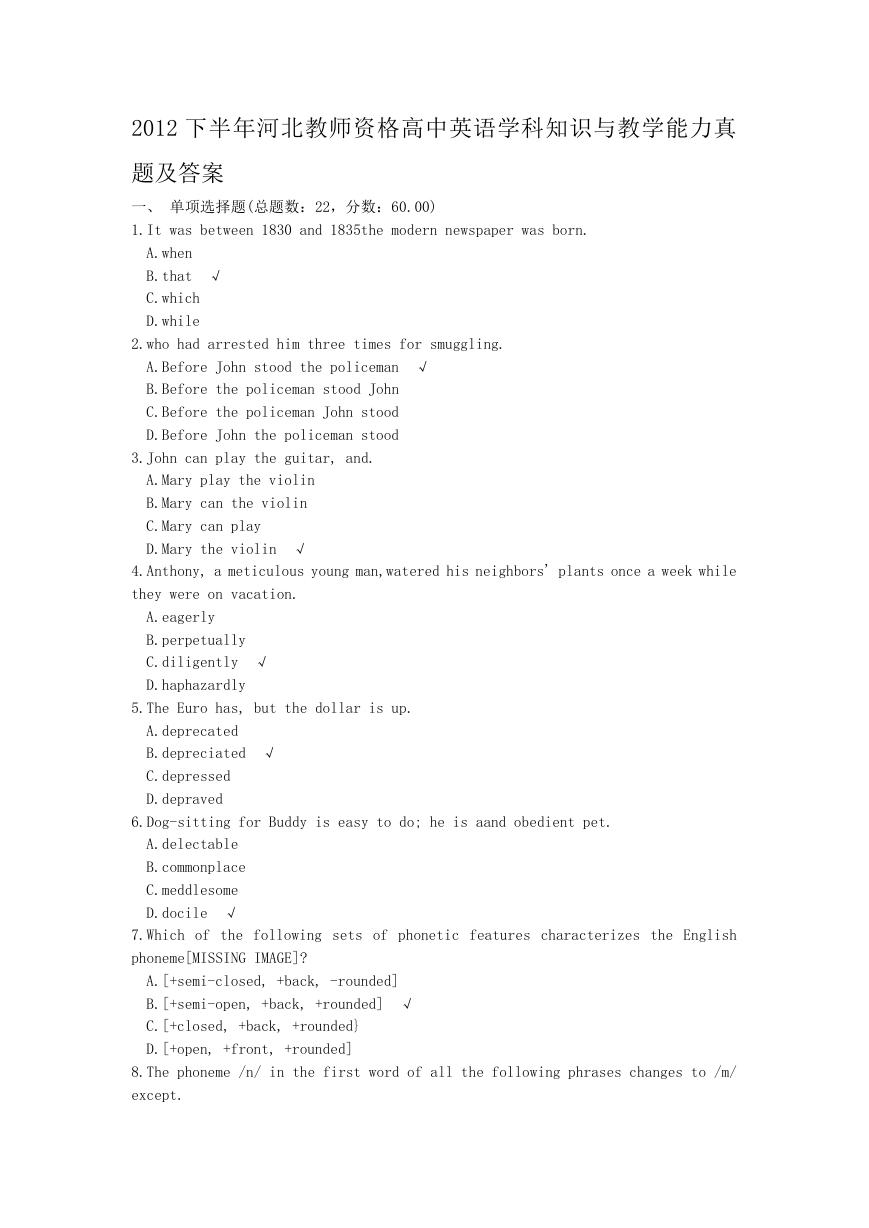

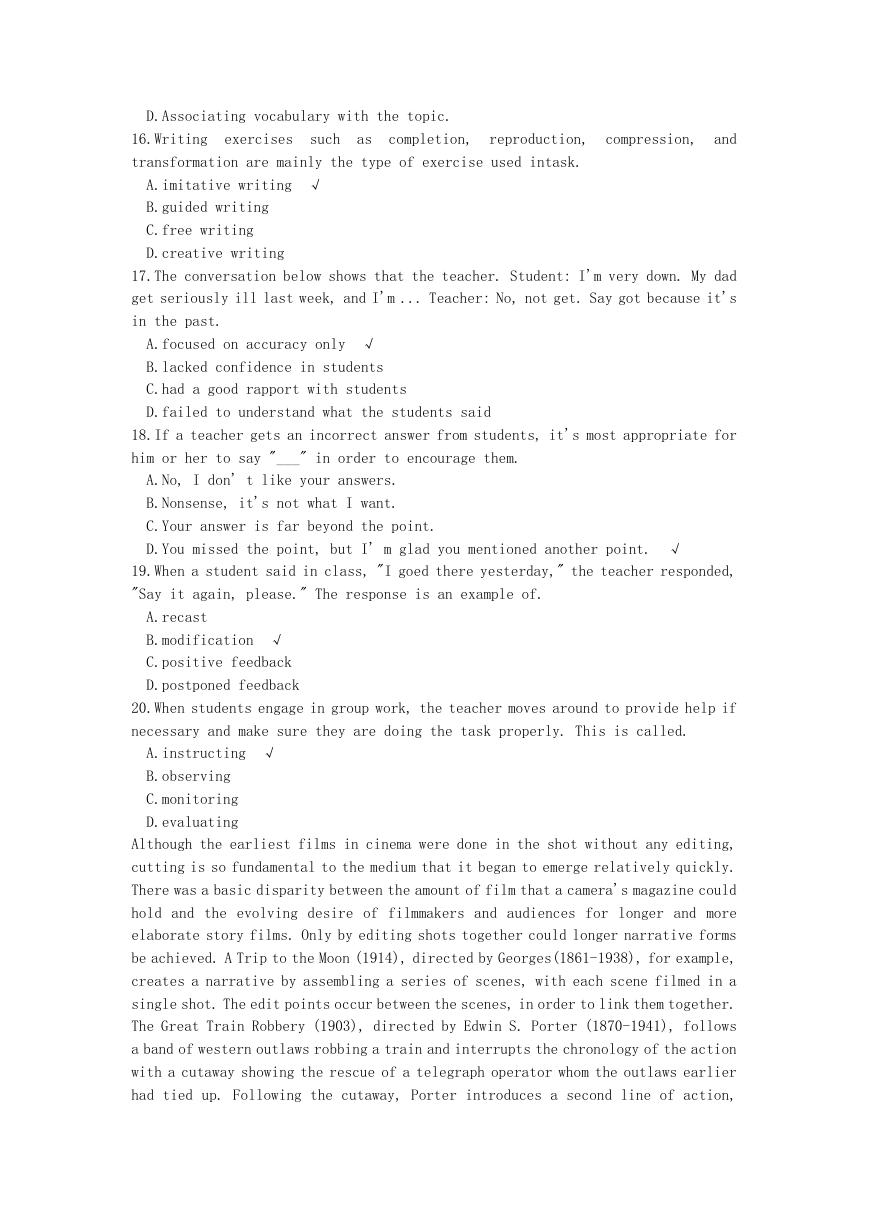
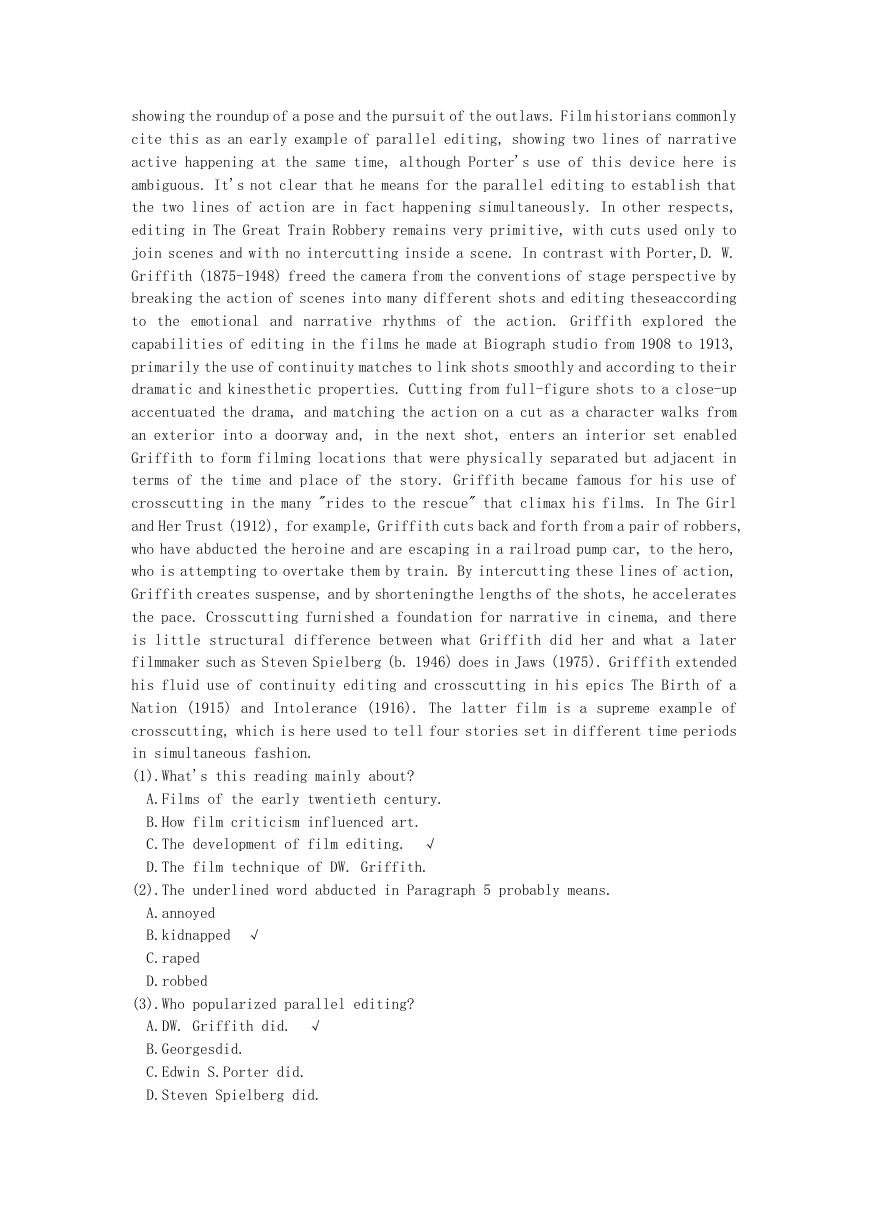
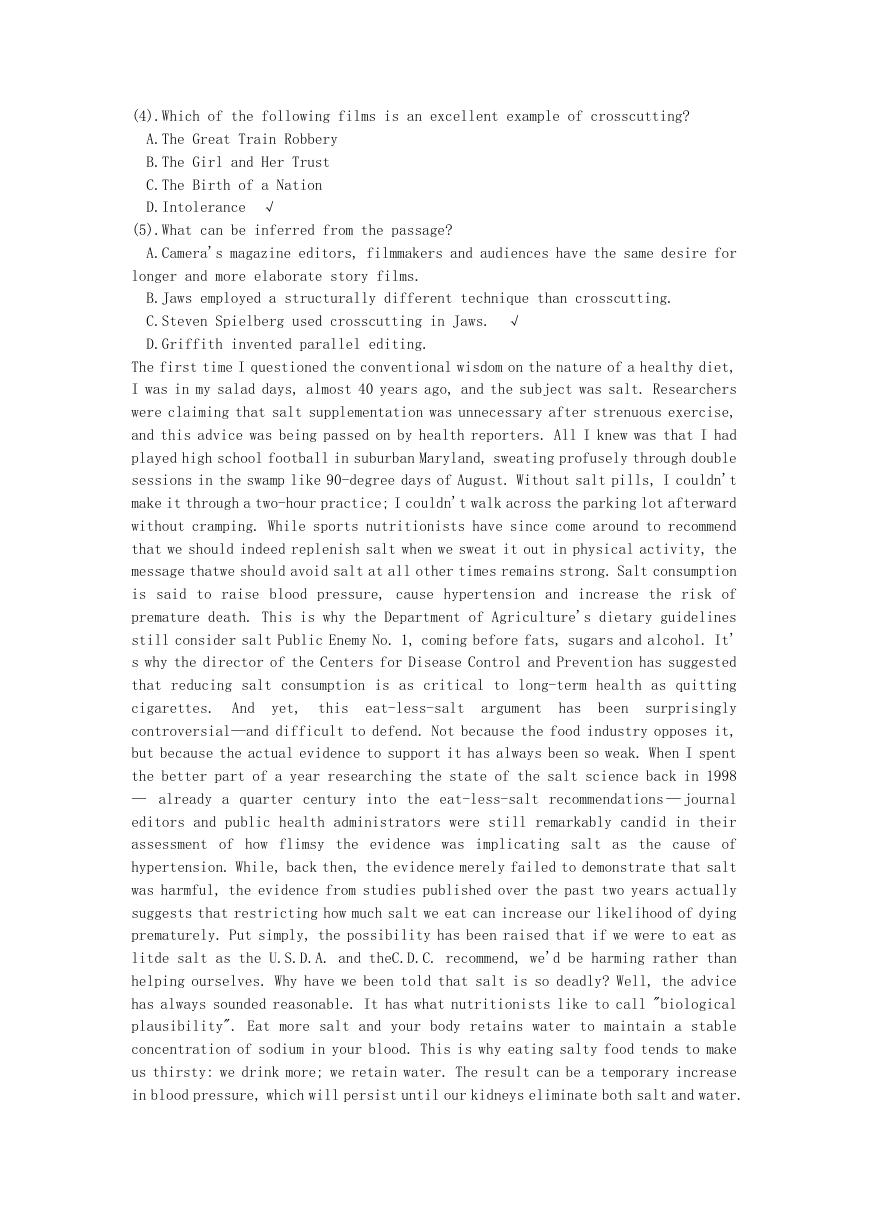
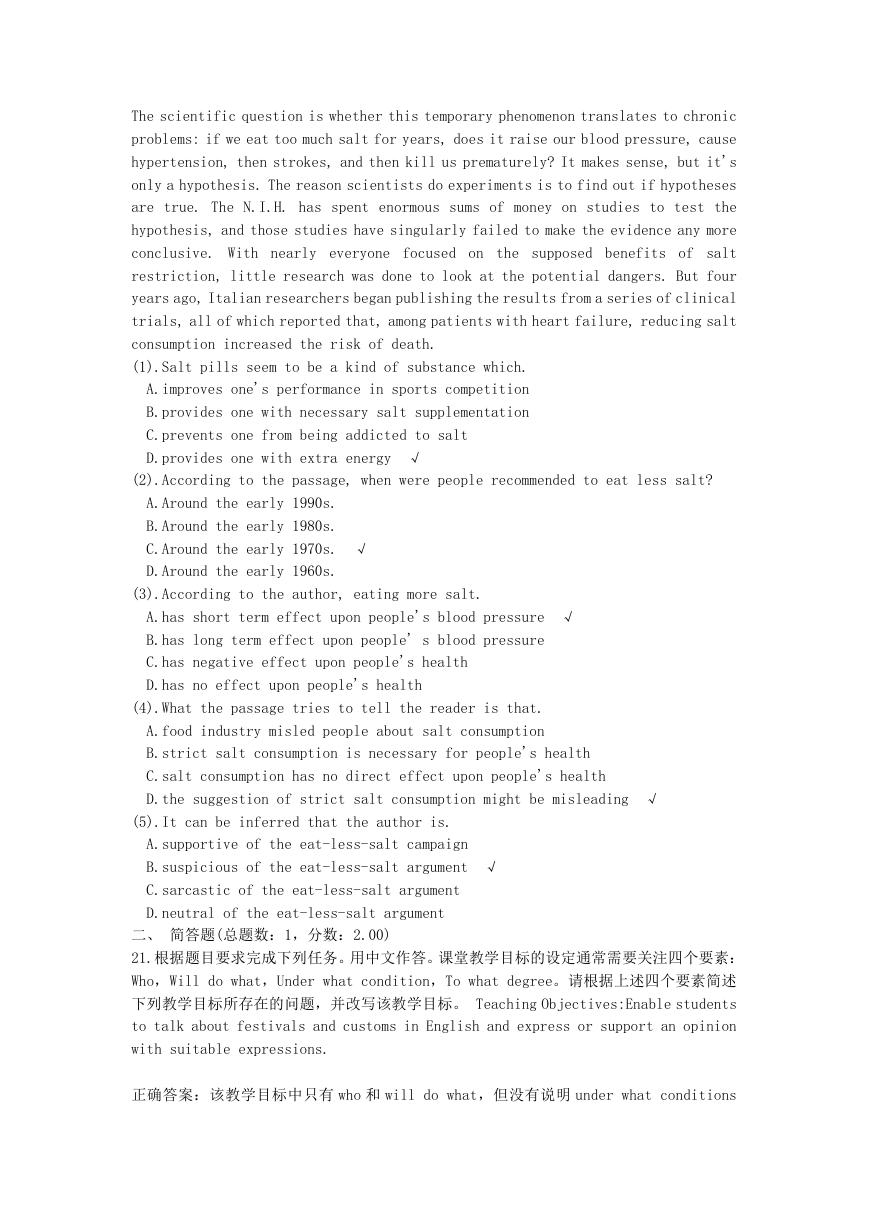
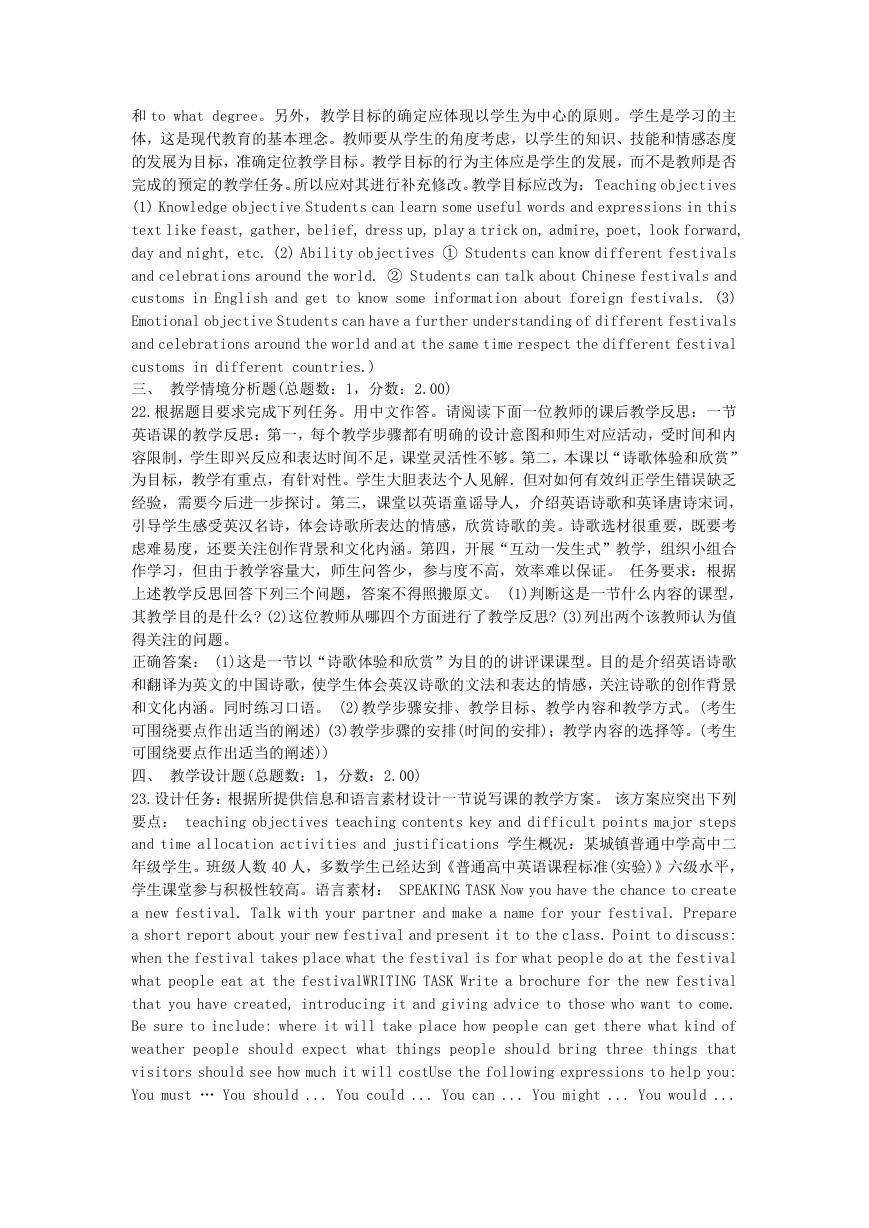
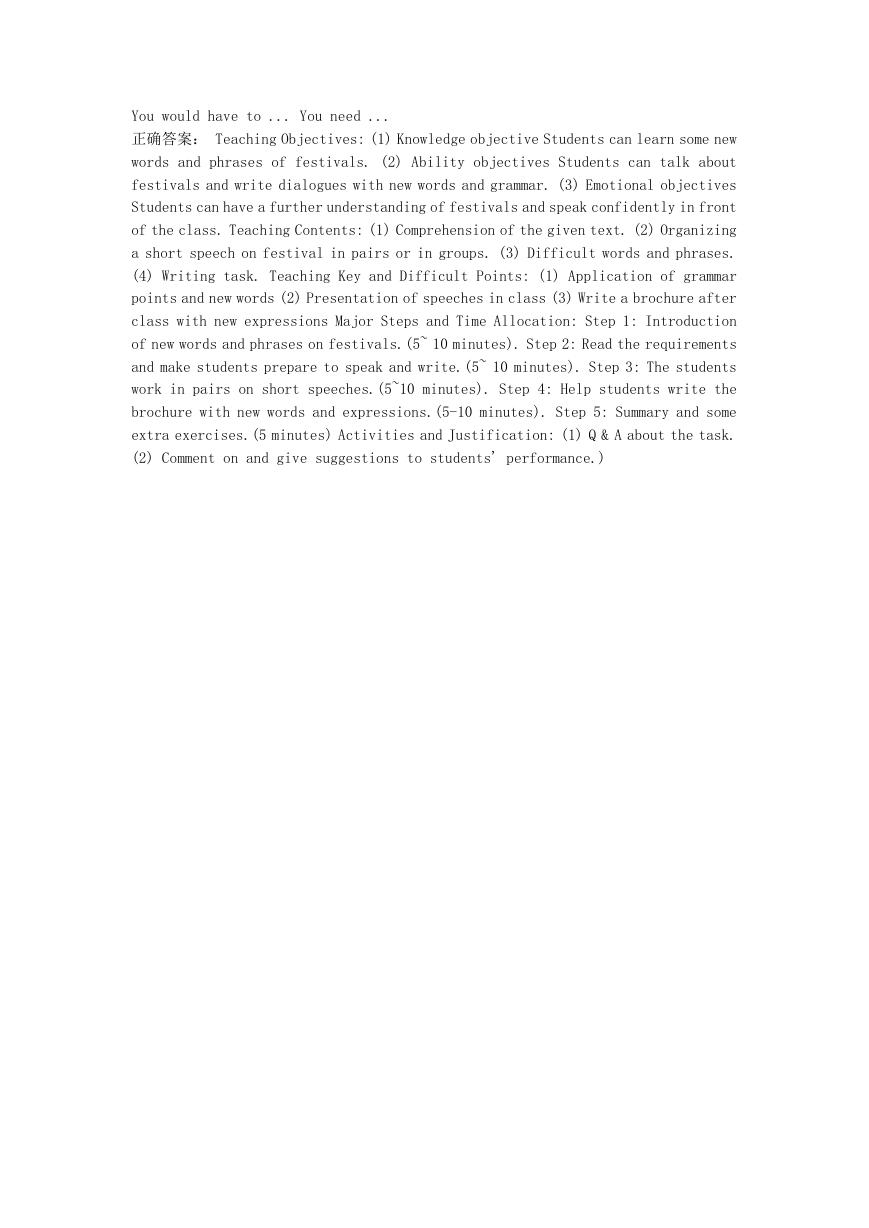








 2023年江西萍乡中考道德与法治真题及答案.doc
2023年江西萍乡中考道德与法治真题及答案.doc 2012年重庆南川中考生物真题及答案.doc
2012年重庆南川中考生物真题及答案.doc 2013年江西师范大学地理学综合及文艺理论基础考研真题.doc
2013年江西师范大学地理学综合及文艺理论基础考研真题.doc 2020年四川甘孜小升初语文真题及答案I卷.doc
2020年四川甘孜小升初语文真题及答案I卷.doc 2020年注册岩土工程师专业基础考试真题及答案.doc
2020年注册岩土工程师专业基础考试真题及答案.doc 2023-2024学年福建省厦门市九年级上学期数学月考试题及答案.doc
2023-2024学年福建省厦门市九年级上学期数学月考试题及答案.doc 2021-2022学年辽宁省沈阳市大东区九年级上学期语文期末试题及答案.doc
2021-2022学年辽宁省沈阳市大东区九年级上学期语文期末试题及答案.doc 2022-2023学年北京东城区初三第一学期物理期末试卷及答案.doc
2022-2023学年北京东城区初三第一学期物理期末试卷及答案.doc 2018上半年江西教师资格初中地理学科知识与教学能力真题及答案.doc
2018上半年江西教师资格初中地理学科知识与教学能力真题及答案.doc 2012年河北国家公务员申论考试真题及答案-省级.doc
2012年河北国家公务员申论考试真题及答案-省级.doc 2020-2021学年江苏省扬州市江都区邵樊片九年级上学期数学第一次质量检测试题及答案.doc
2020-2021学年江苏省扬州市江都区邵樊片九年级上学期数学第一次质量检测试题及答案.doc 2022下半年黑龙江教师资格证中学综合素质真题及答案.doc
2022下半年黑龙江教师资格证中学综合素质真题及答案.doc